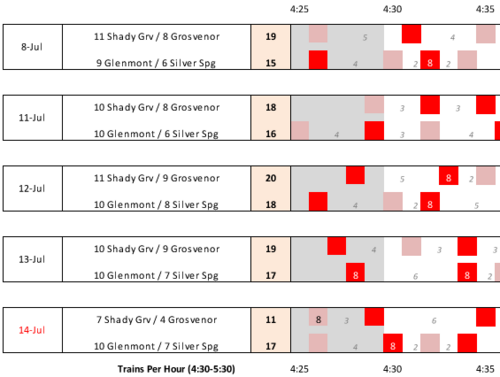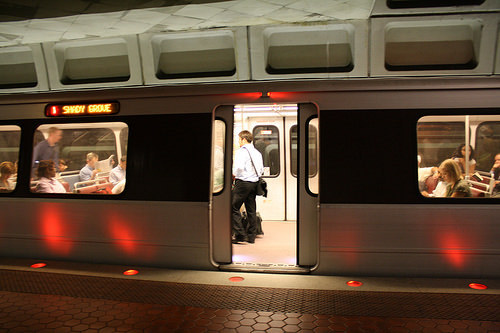Metro’s goal is 20 trains per hour at Farragut North. Here’s what it actually averaged in May, June, and July.
Last year, I found that Metro was running fewer Red Line trains per hour than it had planned during rush hour. I’m counting again this year, and so far the numbers are a mixed bag.
I counted Red Line trains running through Farragut North last year, so I went with the same location this year. I did switch to only doing in-person observations rather than relying on WMATA’s next train arrival data, and to recording from 4:30-5:30 pm (last year, I recorded times in the morning).
The Red line clearly struggled in late May, with an average throughput of 14.6 trains/hour from May 23-27. This is nearly 30% below Metro’s own service guideline of 20 trains/hour. On four of five days, train malfunctions and other problems affected service, though May 25th was quite bad even without any reported delays.
But since that time, service has rebounded and averaged around 17.25 trains/hour over the past two weeks. This is roughly in line with the number from last year’s observation. There weren’t any reported problems during this time, which surely has something to do with trains staying closer to their schedules.

A week’s worth of Red Line throughput data from this month. Click to download a complete version of the data the author collected.
Do schedules need adjusting?
Despite the improvement, Metro only hit its service goal of 20 trains/hour on July 12th, with the trains headed toward Shady Grove. Headways varied significantly, with gaps ranging from two minutes to 10 minutes or more.
Train sequencing showed similar variation. While Metro’s Trip Planner shows that train destinations should alternate (i.e. Glenmont, then Silver Spring, then Glenmont, etc.), it was not uncommon to see trains to the same destination arrive one after the other.
I asked Richard Jordan a WMATA spokesman, how often Metro re-evaluates schedules and whether the Trip Planner is updated to reflect these new times. His response was that “our current service pattern allows for 20 trains per hour on the Red Line. We monitor rail service daily and make adjustments as needed. The online Trip Planner is based on the current schedule.”
Unfortunately, actual service doesn’t match the Trip Planner. While trains should be arriving every three minutes at Farragut North during rush hour, that clearly hasn’t been the case. And trains rarely arrive in the sequence listed online. Certainly neither of these issues is a critical problem, but they are worth addressing.
Why this matters
Metro’s new general manager, Paul Wiedefeld, has said the agency needs to confront “hard truths” and be more transparent with the public. This honesty should extend to Metro’s online schedules and service advisories. Obviously unexpected problems happen that cause delays, but Metro should strive to make sure service matches the online schedule, or vice versa.
Second, SafeTrack makes staying on schedule even more important. Service across all rail lines will be significantly cut at various times over the next 8 months, sometimes as much as 50% or more.
With trains set to only arrive every 10-18 minutes for multiple weeks, it’s critical that they adhere to their modified schedules. Otherwise already lengthy delays around work zones could become unbearable and cause dangerous conditions on platforms and in railcars.
The good news: there are more 8-car trains
On a positive note, while I observed almost no 8-car trains last year (due to problems with the 4000 series), they are much more plentiful this year. And after a brief restriction, multiple new trains are once again traveling the Red line.

